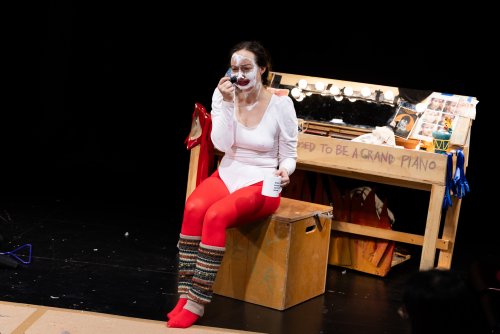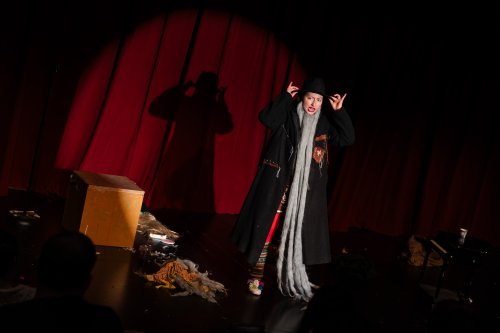Sad Boys in Harpy Land
Alexandra Tatarsky’s one-woman clown show with hints at the Holocaust should be depressing, but she mines it for every scrap of humor with touching characters.

Alexandra Tatarsky in a scene from their “Sad Boys in Harpy Land” at Playwrights Horizons (Photo credit: Chelcie Parry)
[avatar user=”Tony Marinelli” size=”96″ align=”left”] Tony Marinelli, Critic[/avatar]
Alexandra Tatarsky’s Sad Boys in Harpy Land is described as the tale of a young Jewish woman who thinks they are a small German boy who thinks he is a tree. Equal parts sad clown act, absurd comedy, rabid “bildungsroman” (a novel of one person’s formative years or spiritual education, if your college German now fails you), and extended crisis of meaning, it is a wild ride. Tatarsky tells us, “My mind is a hellscape.” And if you think you can breeze your way through her script, she repeats that sentence all in CAPS! The playwright describes it “essentially, it’s a clown show about falling apart.”
This isn’t a simple clown show. If you’ve come looking for Slava’s Snowshow, you’re in the wrong theater. The sad boys referenced are from important, but perhaps obscure, works of literature: Johann Wolfgang von Goethe’s 1796 novel Wilhelm Meister’s Apprenticeship and Günter Grass’s The Tin Drum, which went on to be adapted for film winning the Palme d’Or in 1979 and the Academy Award for Best Foreign Language Film in 1980. We have additional references to Richard Wagner’s Der fliegende Holländer and Amiri Baraka’s play Dutchman which resets the legend in a New York City subway car. And as thier mind is a hellscape, we have the requisite travel through Dante’s Inferno. Pay attention as there may be a quiz later.
Tatarsky strikingly embodies a Wandering Jew, Wilhelm, Wilhelm’s Mama, Oskar (from The Tin Drum), Oskar’s mom, a Harpy, an earthworm, and themself, and the lines between those characters often blur. As Tatarsky more than once speaks about process as an artist, they shine the light on Wilhelm and Oskar. Wilhelm is a young bourgeois man who makes flailing attempts at committing himself to theatermaking. The attempts just happen to coincide with the expansion of the Prussian Empire, thus resulting in the sad rich boy ultimately doing nothing. Oskar Matzerath is a very unusual child who refuses to leave the womb until promised a tin drum by his mother. Mature way beyond his years, he finds the world filled with hypocrisy and injustice and vows on his third birthday to never grow up. Placed in a war setting, he beats his tin drum incessantly and screams in protest loudly enough to shatter glass as the Nazis rise to power around his home in Danzig.
What makes Sad Boys in Harpy Land so intriguing is while the actress seems firm in their confessions of having no words (like Wilhelm getting to the theater for a performance without having written a word of the script), it is all part of a larger framework in which we discover more and more of a strategy of engaging the audience. It can’t all be off the cuff; after all, the critics in attendance have been provided with their script. What we come to realize is that their fearless visuals are very much grounded in a very personal piece about an artist’s process and how we are conscious of the layers as they are revealed. Probably because this is considered “performance art” rather than a “play,” it recalls a landmark piece that was daring, as it was rogue, way back in 1964. Yoko Ono’s Cut Piece also removed layers, in a very literal way.

Alexandra Tatarsky in a scene from their “Sad Boys in Harpy Land” at Playwrights Horizons (Photo credit: Chelcie Parry)
In performance, Ms. Ono sat on a stage and invited the audience to approach her and cut away her clothing, so it gradually fell away from her body. She challenged the neutrality of the relationship between a viewer and an art object. Like Ono, Tatarsky, as a second act, invites the audience “backstage.” We leave our seats and climb on stage to the other side of the curtain and are positioned in a semi-circle either on the floor, sitting or standing, so the proximity of us to Tatarsky can sometimes be mere inches. Even for an audience member who comes from a performance background, this can be very titillating. We see how it all works. The thought that will smack you in the face at some point is how all the sequences have examined a cloaked self-loathing at not being able to do something, to complete something, to change something.
When we first meet the actress, they are the Wandering Jew complete with a battered overcoat and hat and a very long fake beard. When we follow them in the second act, we come face to face with the fire-engine-red hand crank that winds and unwinds the interminable beard. Thier clown costume, which eventually evolves into a minimal white unitard and red leggings that later do come all the way up to cover their breasts, has enough room to pull out a Styrofoam head which thye has “birthed.” We see how the emotionally damaging harpy comes into being. Kudos to the ingenious costume (as well as scenic and props) design of Andreea Mincic.
First, what appear to be pink Playtex gloves get used as footwear for Tatarsky’s feet. The outfit that keeps building on them has plastic forks sewn into the fingers to create the harpy’s talons. The costume is quite a lesson in what can be done with found objects. Even as we look around backstage, it is a treasure trove of what can be discovered beyond the stage curtain. The costume racks and collections of props create wide-eyed wonder in direct response to what in the first act was a somewhat bare stage with a coatrack, microphone stand, and an upright piano. As minimal as that first act is, it is Tatarsky themself that filled the stage.
Shane Riley’s atmospheric sound compositions and Masha Tsimring’s lighting are striking complementary characters in this piece, as demonstrated in Tatarsky’s opening redolent of borscht belt standup and sophomoric shock jocks. Iris McCloughan’s direction is a supreme feat of giving the actress enough rope to hang themself and they will create a wig from that rope. The script gives the illusion of “making it up as they go along” but the director has found ways to channel that, particularly in following up zany moments with those of sheer pathos. When everyone is backstage, the Wandering Jew is back tugging a sack of potatoes (and onions, and miraculously pears). Crying woe and “Despair” becomes “Oh, this pear!” This is in tandem with the evolution of the Jew into the Worm, a character that tries to present hope and resolution to the character of Wilhelm, therein it is hope and resolution to Oskar and Tatarsky as well.

Alexandra Tatarsky in a scene from their “Sad Boys in Harpy Land” at Playwrights Horizons (Photo credit: Chelcie Parry)
Tatarsky uses language in a fresh way, ultimately giving the sensation of having created their own. There are so many thoughts overlapping, and there are accompanying unintelligible sounds and gurgling (some of that happens during her coffee “breaks” and those coffee cups seem to be hidden absolutely everywhere), yet we follow them. When they references a new text, they will nonchalantly drop “I assume everyone here has read the book, yah? Great.” Of course, hasn’t everyone read Die Ausbildung und Reisen von Wilhelm Meister??? Their spontaneous body language may very well be choreographed but even there we have a very approachable and comforting whimsy throughout.
Add to that some very haunting imagery, particularly when we are on stage with Tatarsky. The little boy who “becomes” the tree starts having his branches broken and scattered. Some of the actress’ props and costume pieces complete a circle on stage, in effect creating a “safe place” from which to gather thoughts or scream or cry or sing.
When the play is over, in actuality they are still talking to us while they walks away from us, we are all rapt in Tatarsky’s exit through the theater proper. Were they done? Are we done? Playwrights Horizon’s artistic director Adam Greenfield supplies Notes on Sad Boys in Harpy Land that explains how the company’s decades of programming had excluded playwrights who create new work via interdisciplinary, non-literary methods such as improvisation, ensemble-devised work and physical theater. This production, and probably the other two solo plays that are being presented in repertory with this one, School Pictures and Amusements, came out of a search for playwrights who might never have considered the organization a home for their work. Well, so far, Sad Boys in Harpy Land and Alexandra Tatarsky look right at home.
Sad Boys in Harpy Land (extended through December 17, 2023)
Playwrights Horizons
Peter Jay Sharp Theater, 416 West 42nd Street, in Manhattan
For tickets, visit http://www.playwrightshorizons.org
Running time: 90 minutes without an intermission






Leave a comment